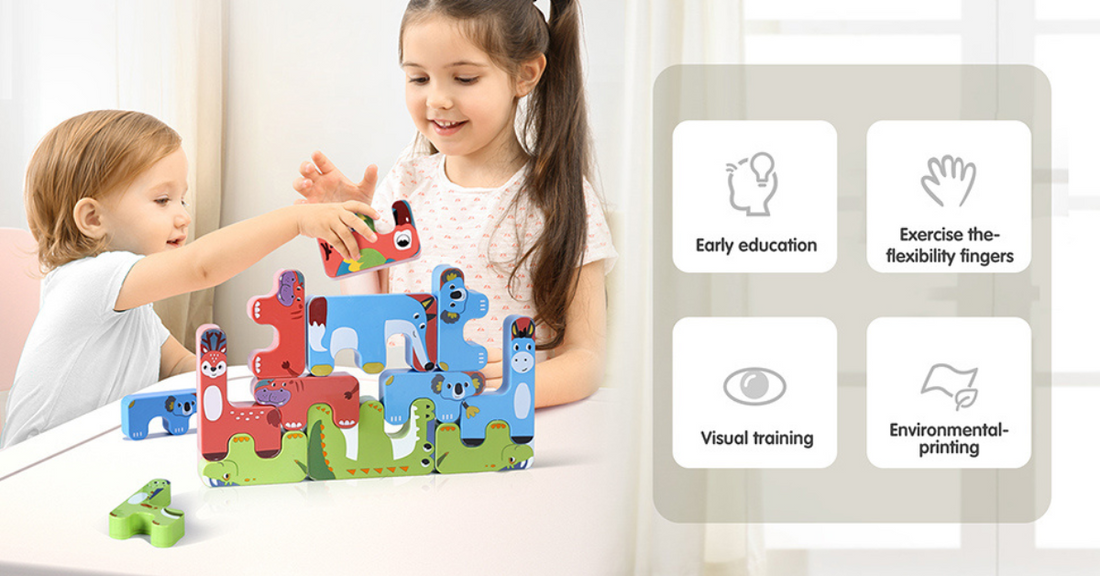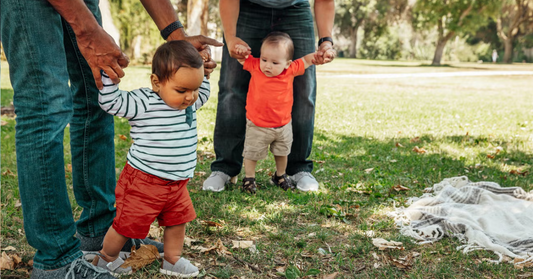Sinnesspielzeug für Kleinkinder: Sind sie nach dem Alter wirklich notwendig?

Sind Kleinkinder „zu alt“ für sensorisches Spielzeug? Auf keinen Fall! Erfahren Sie, wie sensorisches Spielen die motorischen Fähigkeiten, die Problemlösungskompetenz und die soziale Entwicklung von 2- bis 3-Jährigen fördert.
Wenn Sie ein Kleinkind haben, haben Sie wahrscheinlich unzählige Anzeigen, Instagram-Posts oder Pinterest-Boards gesehen, die die magischen Vorteile von „sensorischem Spielzeug“ hervorheben. Die meisten dieser Spielzeuge scheinen jedoch auf Säuglinge oder sehr junge Babys ausgerichtet zu sein. Sind Kleinkinder also zu alt für sensorisches Spielzeug? Und was hat es eigentlich mit all diesen Sinnesaktivitäten auf sich?
Lassen Sie uns untersuchen, warum sensorisches Spielen für Ihr zwei- oder dreijähriges Kind unglaublich nützlich (und unterhaltsam!) ist und wie Sie es in die Spielzeit Ihres Kindes integrieren können.
Sensorisches Spielen verstehen: Was genau ist das?
Sensorisches Spielen bezieht sich auf Aktivitäten, die einen oder mehrere der fünf Sinne Ihres Kindes stimulieren – Tasten, Sehen, Hören, Riechen und Schmecken. Das kann so einfach sein wie Spielen im Wasser oder Sand, das Erkunden von Texturen oder das Hören von Musikinstrumenten.

Der Grund für die zunehmende Beliebtheit sensorischer Spiele liegt nicht nur im Marketing-Hype, sondern auch in der fundierten Entwicklungsforschung. Sensorische Spiele helfen Kleinkindern, wichtige Fähigkeiten zu entwickeln, darunter:
- Fein- und Grobmotorik
- Kognitive Fähigkeiten und Problemlösungsfähigkeiten
- Sprach- und Kommunikationsentwicklung
- Emotionale Regulierung und soziale Fähigkeiten
- Kreativität und fantasievolles Spiel
Kurz gesagt: Sensorisches Spielen ist für Kleinkinder eine natürliche und freudige Möglichkeit, die Welt um sie herum zu erkunden und zu verstehen.
Sind Kleinkinder „zu alt“ für sensorisches Spielzeug?
Auf keinen Fall! Kleinkinder im Alter von zwei und drei Jahren befinden sich in einer entscheidenden Entwicklungsphase. In diesem Alter gewinnt das sensorische Spielen noch mehr an Bedeutung, da Kleinkinder beginnen, Ursache-Wirkungs-Beziehungen zu erforschen, Sprache und Wortschatz zu üben und beim Spielen nach Unabhängigkeit zu streben.
Kleinkinder sind nicht zu alt – sie sind tatsächlich im perfekten Alter, um sich intensiver und kreativer mit sensorischen Aktivitäten zu beschäftigen.
Unordentliches vs. strukturiertes sensorisches Spiel: Ist eines besser?
Sie haben vielleicht schon bemerkt, dass viele sensorische Aktivitäten schmutzig werden können – denken Sie an Fingermalen, Spielen mit Matsch oder Experimentieren mit Wasser. Schmutziges Spielen bietet fantastische Vorteile, wie die Förderung von Kreativität, sensorischer Verarbeitung und motorischen Fähigkeiten.
Aber auch strukturierte, weniger chaotische sensorische Aktivitäten (wie das Stapeln von Spielzeug oder Puzzles) sind hilfreich. Sie vermitteln wichtige Entwicklungsfähigkeiten wie Konzentration, logisches Denken und Hand-Auge-Koordination.
Idealerweise bieten Sie eine Mischung aus sowohl chaotische als auch strukturierte sensorische Aktivitäten um sicherzustellen, dass Ihr Kleinkind ausgewogene und abwechslungsreiche Erfahrungen macht.
Sensorisches Spielzeug: Kaufen oder selbst machen?
Sie müssen kein Vermögen für auffälliges sensorisches Spielzeug ausgeben. Tatsächlich können alltägliche Haushaltsgegenstände leicht in spannende Sinneserlebnisse verwandelt werden:
- Küchenspiel: Messbecher, Löffel, Wasser, Reis oder getrocknete Bohnen ergeben einen fantastischen Sensorikbehälter.
- Erkundung im Freien: Blätter, Stöcke, Steine, Erde oder Sand bieten endlose sensorische Möglichkeiten.
-
Home Knete gemacht: Einfache Rezepte ergeben einen sicheren, weichen Teig, den Ihr Kleinkind formen, rollen und modellieren kann.

Allerdings haben im Handel erhältliche sensorische Spielzeuge auch ihre Vorteile:
- Komfort und einfache Reinigung.
- Sicherheitsgarantie (ungiftige Materialien, keine Erstickungsgefahr).
- Haltbarkeit und einfache Lagerung, besonders hilfreich auf Reisen oder bei vielbeschäftigten Menschen.
Letztendlich bietet Ihnen eine Kombination aus selbstgemachtem sensorischem Spiel und sorgfältig gekauftem Spielzeug Flexibilität und Komfort.
Die 5 besten sensorischen Spielzeuge, die Ihr Kleinkind lieben wird
Hier sind fünf zeitlose sensorische Spielzeuge, die einen großen Entwicklungswert und langfristiges Spielpotenzial bieten:
1. Stapelblöcke
Die unendlich vielseitigen Bausteine fördern räumliches Denken, motorische Koordination und Kreativität. Wählen Sie Qualitätsblöcke die glatt, ungiftig und langlebig sind.

2. Stapelbecher
Stapelbecher sind einfach und erschwinglich und verbessern die motorischen Fähigkeiten, das kognitive Verständnis von Größe und Ordnung und sogar das fantasievolle Spielen (aus ihnen lassen sich ganz einfach Tassen, Hüte oder Burgen bauen!).
3. Kugelbahn aus Holz
Kleinkinder müssen beim Umgang mit kleinen Murmeln beaufsichtigt werden, Murmelbahnen eignen sich jedoch hervorragend, um Ursache und Wirkung, logisches Denken und Problemlösungsfähigkeiten zu lehren.
4. Holzeisenbahn-Sets
Über herkömmliches sensorisches Spielzeug hinaus fördern Eisenbahnsets fantasievolles Rollenspiel, motorische Koordination, visuelle Planung und taktiles Erkunden.
5. Musikinstrumente (e.g., Xylophon)
Musikinstrumente wie ein Xylophon stimulieren die Hör- und Sehsinne und fördern das Experimentieren mit Klang, Rhythmus und Koordination.
Was ist, wenn mein Kleinkind kein Interesse an sensorischem Spiel hat?
Jedes Kind ist einzigartig. Wenn Ihr Kleinkind sensorischen Aktivitäten widersteht, versuchen Sie diese Tipps:
- Modellieren Sie das Verhalten: Spielen Sie neben Ihrem Kind und zeigen Sie Neugier und Begeisterung.
- Fangen Sie klein an: Führen Sie zunächst einfachere sensorische Aktivitäten ein und steigern Sie die Vielfalt schrittweise.
- Reduzieren Sie Ablenkungen: Wenn Ihr Kleinkind an elektronisches Spielzeug oder Bildschirme gewöhnt ist, kann es Geduld und sanfte Ermutigung erfordern, zu aktiverem sensorischem Spielen überzugehen.
Bei anhaltendem Desinteresse am selbstständigen Spielen sollten Sie mit Ihrem Kinderarzt sprechen, aber normalerweise brauchen Kleinkinder einfach Zeit, Geduld und gelegentliches Vorführen von Ihnen.
Sensorisches Spielzeug vs. Montessori-Spielzeug: Was ist der Unterschied?
„Sensorisches Spielzeug“ ist ein weit gefasster Begriff, der nahezu jedes Spielzeug oder Material umfasst, das die Sinne anspricht. Montessori-Spielzeuge orientieren sich jedoch speziell an der Montessori-Philosophie und legen Wert auf:
- Natürliche, nachhaltige Materialien (Holz, Metall, Stoff)
- Passives Spielzeug, das die aktive Beteiligung des Kindes erfordert (keine auffälligen elektronischen Komponenten)
- Klarer Entwicklungszweck, der oft nur auf eine oder zwei spezifische Fähigkeiten gleichzeitig abzielt
- Altersgerechte Herausforderungen zur Förderung der Unabhängigkeit und Konzentration
Ein auffälliges, batteriebetriebenes Musikspielzeug stimuliert zwar technisch gesehen die Sinne, entspricht jedoch nicht der Montessori-Pädagogik, da es eher passiv unterhält als zum aktiven Erkunden und Entdecken anzuregen.
Abschließende Gedanken: Sensorisches Spielen ist mehr als nur ein Trend
Sensorisches Spielen ist nicht nur ein weiterer Erziehungstrend; es ist ein grundlegender Bestandteil der frühkindlichen Entwicklung und bietet endlose Möglichkeiten zum Lernen, Wachsen und Entdecken. Kleinkinder im Alter von zwei oder drei Jahren sind sicherlich nicht „zu alt“ – im Gegenteil, sensorisches Spielen wird noch wirkungsvoller, wenn sie neugieriger, kreativer und unabhängiger werden.
Indem Sie Ihrem Kind eine ausgewogene Mischung aus chaotischen und strukturierten sensorischen Aktivitäten bieten, kombiniert mit sorgfältig ausgewählten Spielsachen und Alltagserlebnissen, bereiten Sie es auf eine erfolgreiche Entwicklung und lebenslanges Lernen vor.







0 Kommentare